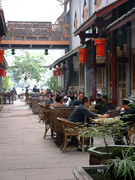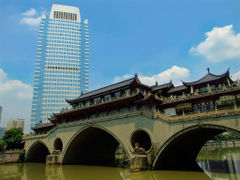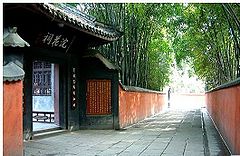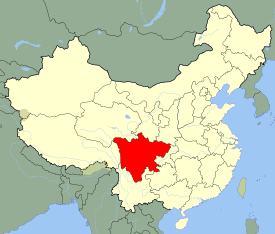Chengdu
| Chengdu 成都 |
|||
|---|---|---|---|
| — Sub-provincial city — | |||
| 成都市 | |||
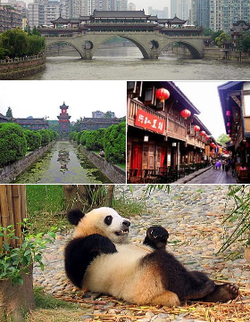 |
|||
|
|||
| Nickname(s): Rongcheng (蓉城) (The Hibiscus City) | |||
| Motto: 和谐包容,智慧诚信,务实创新 (Harmony and Tolerance, Wisdom and Integrity, Truth-seeking and Innovation) | |||
.png) |
|||
| Coordinates: | |||
| Country | |||
| Province | Sichuan | ||
| Settled | 5th century BC | ||
| Established | 311 BC | ||
| City seat | Qingyang District | ||
| Divisions - County-level |
9 districts, 4 county-level cities, 6 counties |
||
| Government | |||
| - Type | Sub-provincial city | ||
| - CPC Party Chief | Li Chuncheng (李春城) | ||
| - Mayor | Ge Honglin (葛红林) | ||
| Area | |||
| - Total | 12,390 km2 (4,783.8 sq mi) | ||
| Elevation | 500 m (1,640 ft) | ||
| Population | |||
| - Total | 11,000,670 | ||
| - Density | 887.9/km2 (2,299.6/sq mi) | ||
| - Major Nationalities | Han | ||
| Time zone | China Standard (UTC+8) | ||
| Postal code | 610000-611944 | ||
| Area code(s) | 28 | ||
| GDP (nominal) Total (2009) | ¥ 450.26 billion (US$65.956 billion) | ||
| GDP (nominal) Per Capita (2009) | ¥ 35,215 (US$5,159) | ||
| License Plate Prefix | 川A 川O (Government) | ||
| Website | http://www.chengdu.gov.cn | ||
| Chengdu | |||||||||||||||||
|---|---|---|---|---|---|---|---|---|---|---|---|---|---|---|---|---|---|
| Chinese name | |||||||||||||||||
| Chinese | 成都 | ||||||||||||||||
| Hanyu Pinyin | Chéngdū | ||||||||||||||||
| Literal meaning | Become Capital | ||||||||||||||||
|
|||||||||||||||||
| Sichuanese name | |||||||||||||||||
| Sichuanese | Cen2du1 | ||||||||||||||||
Chengdu (Chinese: 成都; Sichuanese Pinyin: Cen2du1; Sichuanese pronunciation: [tsʰən21tu55]; Wade–Giles: Ch'eng-tu), located in southwest People's Republic of China, is the capital of Sichuan province and a sub-provincial city. Chengdu is also one of the most important economic centers, transportation and communication hubs in Western China. According to the 2007 Public Appraisal for Best Chinese Cities for Investment, Chengdu was chosen as one of the top ten cities to invest in out of a total of 280 urban centers in China.[1]
More than four thousand years ago, the prehistorical Bronze Age culture of Jinsha (Chinese: 金沙; pinyin: Jīnshā) established itself in this region. The fertile Chengdu Plain, on which Chengdu is located, is called Tianfuzhi guo (simplified Chinese: 天府之国; pinyin: Tiānfǔzhi Guó) in Chinese, which literally means "the country of heaven", or more often seen translated as "the Land of Abundance". It was recently named China's 4th-most livable city by China Daily.[2]
Contents |
City nicknames
The name "Chengdu" has never changed since the city was founded, and the city has always been in the same location. The nicknames below are not formal names.
- The Brocade City: Jinchéng, 锦城
In the Western Han Dynasty (206 BC-23 AD), brocade produced in Chengdu enjoyed great popularity among the royal and elite class in China. An emperor created the office of Jin Guan (锦官) to oversee brocade production in Chengdu. Since then, Chengdu has been called "Jin Guan Cheng" (锦官城) meaning Brocade Official's City, or in its short form, "Jin Cheng" (锦城) meaning Brocade city.
- The City of Hibiscus: Róngchéng, 蓉城
In the Five Dynasties and Ten Kingdoms Period (907-960), Mengchang, the king of the Later Shu Kingdom, ordered the planting of hibiscus on the fortress wall surrounding the city. After this, Chengdu started being called the City of Hibiscus. Nowadays, the hibiscus is still the city flower of Chengdu, but the last city wall was torn down in the 1960s, along with the Royal Palace situated in the middle of the city, where the statue of Mao Zedong now stands.
History
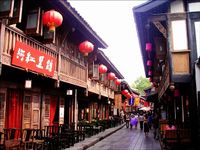
In the early 4th century BC, the 9th Kaiming king of the ancient Shu moved his capital to the city's current location from today's nearby Pixian. He was said to have been inspired to move his capital by the ancient story of King Tai of Zhou, Grandfather of King Wu of Zhou. History recorded King Tai of Zhou's move as "it took a year to become a town; it took three years to become a capital". Following this, the king of Shu named the new city as "Cheng Du", which means "become a capital" (In Chinese, the word "cheng" means "become", "du" means "capital"). There are, however, several versions of why the capital was moved to Chengdu, and more recent theories of the name's origin point to it as stemming from, or referring to, earlier non-Han inhabitants and/or their languages.
After the conquest of Shu by the State of Qin in 316 BC, a new city was founded by the Qin general Zhang Yi (who as a matter of fact had argued against the invasion). This can be seen as the beginning of the Chinese Chengdu. It was renamed Yìzhou (益州) during the Han Dynasty.
During the partition following the fall of the Eastern Han Dynasty, i.e. the era of the Three Kingdoms, Liu Bei founded the southwest kingdom of Shu-Han (蜀汉; 221-263) with Chengdu as its capital.
During the Tang Dynasty, both the "Poet God" Li Bаí (李白) and the "Poet Sage" Dù Fǔ (杜甫) spent some part of their lives in Chengdu. Du Fu constructed the celebrated "Caotáng" (thatched cottage or grass-hut) in the second year of his four-years stay (759-762). But today's Caotang, a rather sumptuous house in the traditional style, was only constructed in 1078 in memory of Du Fu. As early as the Tang dynasty more than 1,200 years ago, Chengdu became one of the foremost commercial cities in China, second only to Yangzhou.
Chengdu was also the birthplace of the first widely used paper money in the world (Northern Song Dynasty, around A.D. 960). The Qingyang Gong Taoist temple was built in Chengdu in the ninth century, meaning "Green Goat".
Two rebel leaders, one around the end of Song Dynasty, the other near the end of Ming Dynasty, set up the capitals of their short-lived kingdoms here, called Dàshu (大蜀) and Dàxi (大西), respectively.
In the 13th century, Marco Polo wrote about several bridges in China and the Anshun Bridge (or an earlier version of it) in Chengdu was one of them. He referred to Chengdu as "Sindafu" ("Cheng-Tu_Fu") as the capital of the province of the same name.[3][4][5]
In 1279 the Mongols sacked Chengdu, killing 1.4 million inhabitants in the process.
During the Second World War the Kuomintang (KMT, Chinese Nationalist Party) government under Generalissimo Chiang Kai-shek fled to Sichuan Province to escape the invading Japanese forces. They brought with them businesspeople, workers and academics, who founded many of the industries and cultural institutions which continue to make Chengdu an important center.
In 1944 the American XX Bomber Command launched Operation Matterhorn, an ambitious plan to base B-29 Superfortresses at Chengdu and strategically bomb the Japanese Home Islands. Because the operation required a massive airlift of fuel and supplies over the Himalayas, it was not a significant military success, but it did earn Chengdu the distinction of launching the first serious retaliation against the Japanese homeland.
During the Chinese Civil War, Chengdu was the last city on the Chinese mainland to be held by the Kuomintang-controlled government. R.O.C. President Chiang Kai-shek and his son Chiang Ching-kuo directed the defence of the city at Chengdu Central Military Academy until 1949, when the city fell into Communist hands. The People's Liberation Army took the city on December 10 and the remnants of the Nationalist Chinese government fled to Taiwan.
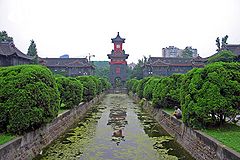
Today the industrial base is very broad, including light and heavy manufacturing, aluminum smelting and chemicals. The textile industry remains important, with cotton and wool milling added to the traditional manufacturing of silk brocade and satin.
Today Chengdu is the headquarters of the Chengdu Military Region.
On May 12, 2008, a magnitude 8.0 earthquake struck causing damage to the area, killing about 80,000 people and injuring 26,413 as of May 12, 2008. 4,021 of the casualties and most of the property damage were from Dujiangyan and Pengzhou, two cities within the administration of Chengdu, the sub-provincial city. Chengdu did not suffer any discernible damage.[6]. The reason why many people died in the surrounding areas had to do with shoddy construction by corrupt companies. Though only 75 kilometers (48 miles) from the epicenter, Chengdu itself was built to earthquake specification, and most buildings there remained intact.
Administrative divisions
Chengdu is a sub-provincial city. It has direct jurisdiction over 9 districts (区 qu), 4 county-level cities (市 shi) and 6 counties (县xian) :
| Map | ||||||
|---|---|---|---|---|---|---|
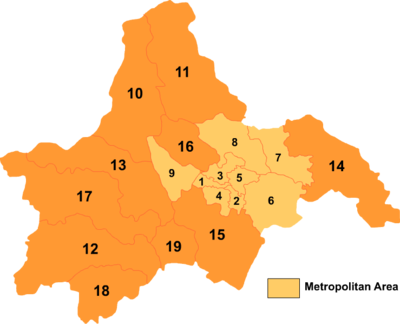 |
||||||
| # | Name | Hanzi | Hanyu Pinyin | Population (2004 est.) | Area (km²) | Density (/km²) |
| City proper | ||||||
| 1 | Qingyang District | 青羊区 | Qīngyáng Qū | 480,000 | 66 | 7,273 |
| 2 | Jinjiang District | 锦江区 | Jǐnjiāng Qū | 390,000 | 61 | 6,393 |
| 3 | Jinniu District | 金牛区 | Jīnniú Qū | 660,000 | 108 | 6,111 |
| 4 | Wuhou District | 武侯区 | Wǔhóu Qū | 650,000 | 77 | 8,442 |
| 5 | Chenghua District | 成华区 | Chénghuá Qū | 590,000 | 109 | 5,412 |
| Suburban | ||||||
| 6 | Longquanyi District | 龙泉驿区 | Lóngquányì Qū | 530,000 | 558 | 950 |
| 7 | Qingbaijiang District | 青白江区 | Qīngbáijiāng Qū | 400,000 | 392 | 1,020 |
| 8 | Xindu District | 新都区 | Xīndū Qū | 610,000 | 481 | 1,268 |
| 9 | Wenjiang District | 温江区 | Wēnjiāng Qū | 320,000 | 277 | 1,155 |
| Rural | ||||||
| 10 | Dujiangyan City | 都江堰市 | Dūjiāngyàn Shì | 600,000 | 1,208 | 497 |
| 11 | Pengzhou City | 彭州市 | Péngzhōu Shì | 780,000 | 1,420 | 549 |
| 12 | Qionglai City | 邛崃市 | Qiónglái Shì | 640,000 | 1,384 | 462 |
| 13 | Chongzhou City | 崇州市 | Chóngzhōu Shì | 650,000 | 1,090 | 596 |
| 14 | Jintang County | 金堂县 | Jīntáng Xiàn | 850,000 | 1,156 | 735 |
| 15 | Shuangliu County | 双流县 | Shuāngliú Xiàn | 910,000 | 1,067 | 853 |
| 16 | Pi County | 郫县 | Pí Xiàn | 490,000 | 438 | 1,119 |
| 17 | Dayi County | 大邑县 | Dàyì Xiàn | 500,000 | 1,327 | 377 |
| 18 | Pujiang County | 蒲江县 | Pújiāng Xiàn | 260,000 | 583 | 446 |
| 19 | Xinjin County | 新津县 | Xīnjīn Xiàn | 290,000 | 330 | 879 |
Geography and climate
| Chengdu | ||||||||||||||||||||||||||||||||||||||||||||||||||||||||||||
|---|---|---|---|---|---|---|---|---|---|---|---|---|---|---|---|---|---|---|---|---|---|---|---|---|---|---|---|---|---|---|---|---|---|---|---|---|---|---|---|---|---|---|---|---|---|---|---|---|---|---|---|---|---|---|---|---|---|---|---|---|
| Climate chart () | ||||||||||||||||||||||||||||||||||||||||||||||||||||||||||||
|
||||||||||||||||||||||||||||||||||||||||||||||||||||||||||||
|
||||||||||||||||||||||||||||||||||||||||||||||||||||||||||||

Chengdu has a humid subtropical climate (Koppen Cwa) and is largely mild and humid. Chengdu is situated at the western edge of the Sichuan Basin and is therefore sheltered from northwest winds from Siberia in winter by the Qinling Mountains to the north; the short winter is milder than in the Lower Yangtze because of the sheltering effect of the Qinling. Snow is rare but there are a few periods of frost each winter. The summer is hot and humid, but not to the extent of the "Three Furnaces" (三大火炉) cities of Wuhan, Nanjing, and Chongqing in the Lower Yangtze basin. The average daytime high in July and August is just short of 30 °C (86 °F), with afternoon highs sometimes reaching 33 °C (91 °F). The average low in January is 2.8 °C (37.0 °F), with lows sometimes dropping below freezing. Rainfall is common year-round but peaks in July and August. Chengdu also has one of the lowest sunshine totals in China (less sunshine annually than London), and most days are cloudy and overcast even if without rain. This is especially so in the winter months, when it is typically interminably grey and dreary added the bad air qualtiy. Spring (March-April) tends to be sunnier and warmer than autumn (October-November).
| Climate data for Chengdu (1971-2000) | |||||||||||||
|---|---|---|---|---|---|---|---|---|---|---|---|---|---|
| Month | Jan | Feb | Mar | Apr | May | Jun | Jul | Aug | Sep | Oct | Nov | Dec | Year |
| Source: China Meteorological Administration | |||||||||||||
Culture and folklore
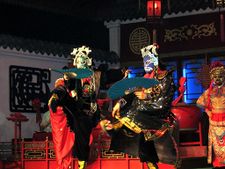
The native language in Chengdu is Sichuanese (四川话), otherwise referred as Sichuan dialect. More precisely, "Chengdu Dialect" (成都话/成都方言) is widely used in lieu of "Sichuanese" due to the largely different accents of Sichuanese speakers residing elsewhere.
People from Chengdu (or Sichuan/Chongqing, in general) tend to eat spicy food. Local specialties include Grandma Chen's Tofu (Mapo doufu), Chengdu Hot pot, and Dan Dan Mien (literally meaning, "Noodles carried on a pole" (Dan Dan Noodles). All three dishes are spicy. Mapo Doufu and Dan Dan Mien contain Sichuan peppers (huājiāo; 花椒; literally "flower pepper") to give them additional flavor.
An article by the Los Angeles Times (2006) called Chengdu "China's party city" for its carefree lifestyle. Chengdu outnumbers Shanghai in the number of tea houses and bars despite having less than half the population. The inhabitants have a reputation in China for having a laid-back attitude and for knowing how to enjoy life.
Gallery
|
Economy
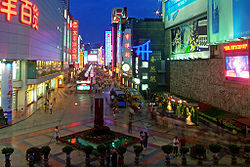
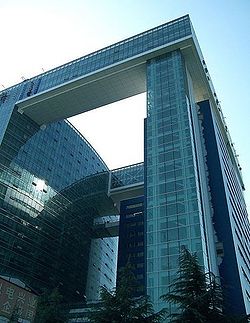
The main industries in Chengdu - which include food, medicine, machinery and information technology - are supported by numerous large-scale enterprises, such as Chengdu Sugar and Wine Co. Ltd., Chengdu Food Group, Sichuan Medicine Co. Ltd., Chengdu Automobile Co. Ltd. etc. Many high-tech enterprises from outside Chengdu are also beginning to settle down there.
Chengdu is becoming one of the favorite cities for investment in western China.[7] Among the World's 500 largest companies, 133 multinational enterprises have had subsidiaries or branch offices in Chengdu by October 2009.[7] These MNEs include Intel, Sony, and Toyota that have assembly and manufacturing bases, as well as Motorola, Ericsson, and Microsoft that have R&D centers in Chengdu.[7]
The National Development and Reform Commission has formally approved Chengdu's proposed establishment of a national bio-industry base there. The government of Chengdu has recently unveiled a plan to create a ¥90 billion bio pharmaceutical sector by 2012.[8] China's aviation industries have begun construction of a high-tech industrial park in the city that will feature space and aviation technology. The local government plans to attract overseas and domestic companies for service outsourcing and become a well-known service outsourcing base in China and worldwide.
Electronic and IT industry
Chengdu has long been established as a national base for electronic and IT industry. The first telecom R&D centre was set up by an Indian Company called Primetel in 1996 and since then the city has developed as the global centre for the telecom R&D industry. Chengdu's growth accelerated alongside the growth of the telecom services sector in India and China. These two countries now account for over 70% of the world telecom market. Several key national electronic R&D institutes are located in Chengdu. Chengdu Hi-tech Industrial Development Zone has attracted a variety of multinationals, at least 30 Fortune 500 companies and 12,000 domestic companies, including Intel, IBM, NOKIA, Motorola, SAP, Siemens, Canon, HP, Xerox, Microsoft, Tieto, NIIT and Wipro, as well as domestic powerhouses such as Lenovo.[9]
Intel's Chengdu factory is its second in China, after its Shanghai factory, and the first such large-scale foreign investment in electronic industry in interior mainland China. Intel, the world's largest chipmaker, has invested US$525 million in two assembly and testing facilities in Chengdu. Following the footsteps of Intel, Semiconductor Manufacturing International Corporation (SMIC), the world's third largest foundry, set up an assembly and testing plant in Chengdu. Intel's rival AMD is likewise set to open an R&D center in this city.
In November 2006, IBM signed an agreement with the Chengdu High-Tech Zone to establish a Global Delivery Center, its fourth in China after Dalian, Shanghai and Shenzhen, within the Chengdu Tianfu Software Park. Scheduled to be operational by February 2007, this new center will provide multi-lingual application development and maintenance services to clients globally in English, Japanese and Chinese, and to the IBM Global Procurement Center, recently located to the southern Chinese city of Shenzhen.[10] On March 23, 2008, IBM announced at the "West China Excellent Enterprises CEO Forum" that the southwest working team of IBM's Global Business Services is now formally stationed in Chengdu. On May 28, 2008, Zhou Weikun, president of IBM China disclosed that IBM Chengdu would increase its staff number from the present 600 to nearly 1,000 by the end of the year.[11][12]
Over the past few years, Chengdu's economy has flourished rapidly. Chengdu has been quick to become a major base for communication infrastructure, with one of China's nine top level postal centers and one of six national telecom exchanges.
In 2009, Chengdu hosted the World Cyber Games Grand Finals (11–15 November). It was the first time China hosted the world's largest computer and video game tournament.[13]
Financial industry
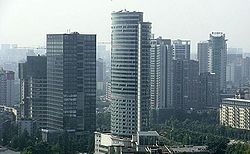
Chengdu is now building itself to be the financial hub for Western China and has successfully attracted major international financial institutions, including Citigroup, HSBC, Standard Chartered Bank, ABN AMRO, BNP Paribas, JPMorgan Chase, The Bank of Tokyo-Mitsubishi UFJ, etc.
Historically, Chengdu has marked its name in the history of financial innovation. The world’s first ever paper currency 'Jiao Zi' was seen in Chengdu in the year 1023, during the Song Dynasty of ancient China.
Now, Chengdu is not only the gateway of Western People's Republic of China for foreign financial institutions, but also a booming town for Chinese domestic financial firms. The Chinese monetary authority, People's Bank of China (China’s central bank), set its southwest China headquarters in Chengdu City. In addition, almost all domestic banks and securities brokerage firms located their regional headquarters or branches in Chengdu. At the same time, the local financial firms of Chengdu are strengthening their presences nationally, notably, West China Securities, GuoJin Securities and Chengdu Commercial Bank. Moreover, on top of banks and brokerage firms, the flourish of local economy lured more and more financial service firms to the city to capitalize on the economic growth. KPMG opened this first west China office in Chengdu City this October, and before the inauguration of KPMG Chengdu office, its rival, Ernst & Young, had already integrated Chengdu into its global operation for several years.
Defense industry
Located within the city limits is the Chengdu Aircraft Company which produces the recently declassified J-10 Vigorous Dragon combat aircraft as well as the JF-17 Thunder, in a joint collaborative effort with Pakistan Air Force. The company is one of the major manufacturers of Chinese Military aviation technology.
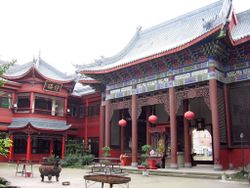
Investment
The Chengdu Statistics Bureau reports that the total investment in fixed assets in 2008 was 301.29 billion yuan (US$43.38 billion). Domestic investment was 180.52 billion yuan (US$26 billion), an increase of 23.5 percent from 2007. The total amount of foreign direct investment reached US$2.25 billion, an increase of 97.3 percent from 2007.
Industrial zones
- Chengdu Economic & Technological Development Zone
- Chengdu Export Processing Zone
- Chengdu Hi-Tech Industrial Development Zone
- Chengdu National Cross-Strait Technology Industry Development Park
Transportation
Chengdu's transportation network is well developed, and Chengdu serves as the starting point for many national highways, with major routes going from Sichuan-Shanxi, Sichuan-Tibet, and Sichuan-Yunnan.
For the year 2007, Chengdu announced the official launch of 37 significant projects, including the Chengdu-Jianyang Expressway in an attempt to accelerate the construction of the experimental district. This project is expected to solve the current transportation problem, which is proved to be the bottleneck in Jianyang's development. Development of major tunnels and the Longquan Lake scenic spot has also been planned to integrate Jianyang better into the Chengdu economic circle.
Several major road projects were also mentioned in the paper: a 15 km tunnel from Shuangliu Taiping to Jianyang Sancha Lake; alteration of the National Expressway 321, from Jiangyang to Longquanyi, totaling 26 kilometers. There will also be a road that connects Longquan Town to Longquan Lake - it will be connected to the Chengdu-Jianyang Expressway and hence shorten the journey by 10 kilometers. The authority has yet to decide whether drivers will have to pay tolls to access the road.
Expressways
By the end of 2008, there are ten expressways, connecting the center of Chengdu to its suburbs. The expressways that will be open to the public by the end of December are the Chenglin Expressway, extensions of Guanghua Avenue, Shawan Line, and an expressway from Chengdu to Heilongtan.
- The toll-free Chengjin Expressway in the east of Chengdu is 38.7 km long, with six lines and designed for travel at 80 km/h. After it opens to the public, it will take only about half an hour to drive from the downtown Chengdu to Jintang, half the time of the current journey.
- The expressway between Chengdu to Heilongtan (Chengdu section), going to the south of the city, is 42 km long. It is also toll-free and a journey from downtown Chengdu to Heilongtan will only take half an hour.
- The extension of Guanghua Avenue, going towards the west of the city, is 11.6 km long with an estimated investment of 300 million yuan. It will cut the journey time from Chongzhou city to Sanhuan Road to less than half an hour.
- The extension of Shawan Road going north will be 8.8 km long, and is designed for travel at 60 km/h. After it is connected to the expressways Pixian–Dujiangyan and Pixian–Pengzhou, it will take only 30 minutes to go from Chengdu to Pengzhou.
- Via the Sichuan-Tibet Highway, from Chengdu to Nagchu (near Lhasa) is a distance of 2028 km.
Highway
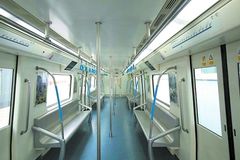
- China National Highway 055
- China National Highway 213
- China National Highway 317
- China National Highway 318
- China National Highway 319
- China National Highway 321
Public transport
The Chengdu Metro seven line subway system has been planned, and Line 1 is under construction. Chengdu was the site of the June 5th bus fire incident.
Air transport
Chengdu is served by the Chengdu Shuangliu International Airport located 16 km southwest of downtown. It has been the busiest airport in Central and Western China and the 6th busiest airport nationwide, with a total of 17.25 million in terms of passenger traffic in 2008.[14]
The Chengdu Airport has constructed a second runway, capable of landing Airbus 380, the largest commercial airplane to date. The second runway had a trial flight in October 2009 and is expected to be in use soon. Chengdu is the fourth city in China with double commercial runways, after Beijing, Shanghai, and Guangzhou. On May 26, 2009, Air China, the Chengdu Government and Sichuan Airport Group signed an agreement to improve the infrastructure of the airport and increase the number of international direct flights to and from Chengdu. The objective is to have a passenger traffic of 40 million by 2015, making Chengdu Airport the fourth international hub in China, after Beijing, Shanghai, and GuangZhou.[14][15]. There is also a long-term plan to build a second airport in Jintang County with five runways. Upon completion, it will take less than 30 minutes to travel from Jintang to downtown Chengdu.[16]
Railway transport
Chengdu is a major railway junction city and rail administrative center in southwestern China. It is the terminus for the Baoji-Chengdu, Chengdu-Chongqing, ChengKun (Chengdu-Kunming) and DaCheng (Chengdu-Dazhou), as well as the Chengdu-Dujiangyan High-Speed Railway. The Chengdu Railway Bureau manages the railway system of Sichuan, Chongqing, Guizhou and Yunnan.
New lines under construction include conventional line to Lanzhou and high-speed lines to Mianyang, Leshan and Chongqing.
Chengdu now has four main train stations. Among them the North Marshalling Station is the largest marshalling station in China[17]. Meanwhile, a new station for passenger transportation is to be built in a few years.
River transport
Located to the northwest of Chongqing, Chengdu has no direct access to the Yangtze River, or any other larger river. However, to ensure that Chengdu's goods have access to the river efficiently, the port cities of Yibin and Luzhou -- both of which are reachable from Chengdu within hours by expressways—on the Yangtze have commenced large-scale port infrastructure development. As materials and equipment for the rebuilding of northern Sichuan are sent in from the East Coast to Sichuan, these ports will see significant increases in throughput.
Education
Chengdu is the center of higher education and scientific research in Southwest China.
Colleges and universities

Chengdu is the center of higher education and scientific research in Southwest China.
National universities include:
- Sichuan University (SCU) (四川大学) (Founded in 1896)
- Southwest Jiaotong University (西南交通大学) (Founded in 1896)
- University of Electronic Science and Technology of China (电子科技大学) (Founded in 1956)
- Southwestern University of Finance and Economics (西南财经大学) (Founded in 1952)
Important provincial universities include:
- Sichuan Normal University (四川师范大学) (Founded in 1946)
- Southwest University for Nationalities (西南民族大学) (Founded in 1951)
- Chengdu Institute Sichuan International Studies University (四川外语学院成都学院) (Founded in 2000)
- Chengdu University of Technology (成都理工大学) (Founded in 1956)
- Southwest Petroleum University (西南石油大学) (Founded in 1958)
- Chengdu University of Traditional Chinese Medicine (CDUTCM) (成都中医药大学) (Founded in 1956)[18]
- Sichuan Conservatory of Music(四川音乐学院) (Founded in 1939)
- Chengdu University of Information Technology (CUIT) (成都信息工程学院) (Founded in 1951)
- Chengdu Kinesiology University (成都体育学院) (Founded in 1942)
- Xihua University (西华大学) (Founded in 1960)
- Chengdu University (成都大学) (Founded in 1978)
- Chengdu Medical College (成都医学院) (Founded in 2004)[19]
- Chengdu College of UESTC (电子科技大学成都学院)
Note: Institutions without full-time bachelor programs are not listed.
International schools
- Chengdu Meishi International School
- Chengdu International School
- The Leman International School - Chengdu
- Quality Schools International
- Eton House
Secondary schools
- Chengdu No.7 High School (成都七中)
- Chengdu Shude High School (成都树德中学)
- Shishi Middle School (成都石室中学)
- Chengdu Experimental Foreign Languages School
- Chengdu Foreign Languages School (成都外语学校)
- Chengdu Shude Experimental School (成都树德实验中学)
- Chengdu Shude Union School (成都树德联校)
- Chengdu Shishi Union School (成都石室联中)
- Chengdu Yulin Middle School (成都玉林中学)
Consulates
The United States Consulate General at Chengdu opened on October 16, 1985. It was the first foreign consulate in west-central China since 1949. Currently eight countries have consulates in Chengdu. The Philippines will open a consulate in Chengdu soon. The United Kingdom also has a visa application center in Chengdu.
| Consulate | Year | Consular District |
|---|---|---|
| 1986 | Sichuan/Chongqing/Yunnan/Guizhou/Tibet | |
| 2003 | Sichuan/Chongqing/Yunnan/Guizhou | |
| 2004 | Sichuan/Chongqing/Yunnan/Guizhou | |
| 2004 | Sichuan/Chongqing | |
| 2005 | Sichuan/Chongqing/Yunnan/Guizhou | |
| 2006 | Sichuan | |
| 2007 | Sichuan/Chongqing/Yunnan/Guizhou/Tibet | |
| 2009 | Sichuan/Chongqing/Shaanxi/Yunnan/Guizhou |
International relations
Twin towns — Sister cities
In 1979, Chengdu signed a sister city agreement with Montpellier, France, the first pair of Sino-French sister cities. Later Chengdu signed sister city agreements with cities in ten countries, as well as signing a friendly region agreement with the Dalarna province in Sweden. Chengdu has had many friendly exchanges with the sister cities. Montpellier, for example, has a Chengdu Street and a Chengdu Plaza. The soccer team Chengdu Blades is owned by Sheffield United F.C.
 Baku, Azerbaijan
Baku, Azerbaijan Montpellier, France; since 1979.
Montpellier, France; since 1979. Ljubljana, Slovenia; since 1981.
Ljubljana, Slovenia; since 1981. Linz, Austria; since 1983.
Linz, Austria; since 1983.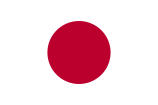 Kofu, Japan; since 1983.
Kofu, Japan; since 1983. Knoxville, United States.
Knoxville, United States. Phoenix, United States; since 1986.
Phoenix, United States; since 1986. Winnipeg, Canada; since 1988.
Winnipeg, Canada; since 1988..svg.png) Mechelen, Belgium; since 1993.
Mechelen, Belgium; since 1993. Volgograd, Russia; since 1994.
Volgograd, Russia; since 1994. Saint-Petersburg, Russia; since 1998.
Saint-Petersburg, Russia; since 1998. Palermo, Italy; since 1999.
Palermo, Italy; since 1999. Gimcheon, South Korea; since 2000.
Gimcheon, South Korea; since 2000. Medan, Indonesia; since 2001.
Medan, Indonesia; since 2001.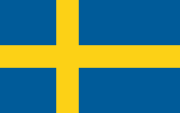 Dalarna (province), Sweden; since 2004.
Dalarna (province), Sweden; since 2004. Bonn, Germany; since 2009.
Bonn, Germany; since 2009.
See also
- List of cities in the People's Republic of China by population
- Capitals of subnational entities of China
- List of current and former capitals of subnational entities of China
London
References
- ↑ Chengdu's June News | All Roads Lead To China
- ↑ Jing, Fu (2006-01-03). "Beijing drops out of top 10 'best city' list". China Daily. http://www.chinadaily.com.cn/english/doc/2006-01/03/content_508828.htm.
- ↑ Quian, Jack, Chengdu: A City of Paradise, 2006. Cf. p.109
- ↑ Marco Polo referred to Chengdu as Sindafu (variously spelled in different editions as "Sin-din-fu". &c.) which was certainly Ch'eng-Tu-Fu (Chengdu), the capital of Sichuan province. Cf. Polo, Chapter XLIV: Concerning the Province and City of Sindafu. See Henry Yule; Henri Cordier (translators and editors), The Travels of Marco Polo, v.2, the complete Yule-Cordier edition. "Let us now speak of a great Bridge which crosses this River within the city. This bridge is of stone; it is seven paces in width and half a mile in length (the river being that much in width as I told you); and all along its length on either side there are columns of marble to bear the roof, for the bridge is roofed over from end to end with timber, and that all richly painted. And on this bridge there are houses in which a great deal of trade and industry is carried on. But these houses are all of wood merely, and they are put up in the morning and taken down in the evening. Also there stands upon the bridge the Great Kaan's _Comercque_, that is to say, his custom-house, where his toll and tax are levied."
- ↑ Mayhew, Bradley; Miller, Korina; English, Alex, South-West China, Lonely Planet Publications, 1998 (2nd edition 2002). Cf. p.19 on the Mongul Reign: Yuan Dynasty.
- ↑ "Casualties in Wenchuan Earthquake" (in Chinese). Sina.com. 2008-05-24. http://news.sina.com.cn/pc/2008-05-13/326/651.html. Retrieved 2008-05-24.
- ↑ 7.0 7.1 7.2 "Chengdu Leading the West (in Chinese)". 2009-10-21. http://finance.ifeng.com/city/cd/20091021/1357840.shtml.
- ↑ "Chengdu Eyes a ¥90b Biopharma Industry (in Chinese)". 2009-10-20. http://thechinaperspective.com/articles/chengdueyesa90bbiopharmindustry6624/index.html.
- ↑ "Branches of Fortune 500 Businesses in Chengdu". 2007-10-29. http://www.investchengdu.gov.cn/investcden/12/4/200710/t20071029_6519.htm.
- ↑ "IBM Expands Global Delivery Capabilities to Inland China". IBM Press Room. 2006-11-27. http://www-03.ibm.com/press/us/en/pressrelease/20680.wss. Retrieved 2009-08-28.
- ↑ "IBM 成都分公司" (in Mandarin). IBM Press Room. http://www-900.ibm.com/cn/chengdu/brief.shtml.
- ↑ "IBM to Further Investment in Chengdu". People's Government of Sichuan Province. http://english.sc.gov.cn/news/briefs/200806/t20080603_286242.shtml.
- ↑ "WCG 2009 in Chengdu, China". http://www.sk-gaming.com/content/16573-WCG_2009_in_Chengdu_China.
- ↑ 14.0 14.1 "Agreement to build an airport hub in Chengdu". People's Net. 2009-05-26. http://politics.people.com.cn/GB/14562/9368961.html.
- ↑ "Chengdu airport". Sina. 2009-05-26. http://finance.sina.com.cn/roll/20090527/11072864377.shtml.
- ↑ "Chengdu connection". China Daily. 2008-01-21. http://www.chinadaily.com.cn/bw/2008-01/21/content_6407282.htm.
- ↑ "Chengdu city info southwest china". http://21asiantravelguide.info/chengdu/index.html. Retrieved 2010-03-05.
- ↑ Chengdu University of Traditional chinese Medicine website
- ↑ Chendy Medical College website (English)
- Mayhew, Bradley; Miller, Korina; English, Alex, South-West China, Lonely Planet Publications, 1998 (2nd edition 2002). Cf. p. 444 for its article on Chengdu.
- Quian, Jack, Chengdu: A City of Paradise, 2006
Further reading
- Ling Zhu, "Chengdu, the city of spice and tea", China Daily, Government of China, Friday, December 22, 2006
External links
- Official Website of the Chengdu Government
- Chengdu expat Community
- A Bird's Eye View of the New Chengdu (July 2008)
|
|||||||||||||||
|
||||||||||||||||||||||
|
|||||
|
|||||||
Portal:China

